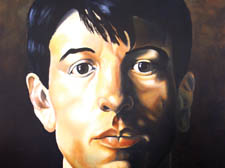|
|
 |
| |

Stanley Spencer, HMP Long Lartin, which won first prize portraiture |
Keeping the spirit alive
The Koestler Trust offers the chance for offenders to experience the redemptive powers of art, writes Sunita Rappai
TWENTY-TWO years ago, Erwin James was sentenced to life imprisonment at the Old Bailey for a crime he has never discussed. The sentencing was a low point in a life that, up to that point, had been characterised by low points.
“That was the lowest point,” he says. “When society has had enough of you and they close the door on you. But looking back, I see it as a turning point.”
James served 20 years of his life sentence before he was released back into society two years ago.
Inside prison he embarked on an education drive, completing an Open University arts degree and writing poetry and small pieces for the prison magazine.
While inside, he started writing a fortnightly column on his life inside the prison for the Guardian.
On his release he was offered a permanent job with the paper. In the last two years, he has had two books published on prison life.
Today, James says he is “blessed” with a life that, at last, is everything it should be. Unsurprisingly, he is also a passionate advocate of prison reform – which is why he was a special guest at the opening of the Koestler Trust exhibition of prisoner art in Kensington on Thursday.
It is exactly for people like James that the Koestler Trust was founded by Arthur Koestler, journalist and author of modern classic, Darkness at Noon, nearly 45 years ago.
Koestler, who died in 1983, experienced several gruelling spells in prison during his lifetime – in the death camps of Spain during the Spanish Civil War, in a detention camp in France during the World War II and in Pentonville in 1940, where he was confined briefly as an “enemy alien”.
The slow “death of the spirit” that he experienced inside convinced him that something was necessary to combat the dehumanising effects of prison life. In 1962, after a sustained campaign, Koestler’s first annual literary and painting competition for prisoners began.
From these humble beginnings, the awards have gone from strength to strength. Each year, prisoners, patients and young offenders submit their work – from art, craft, sculpture, ceramics, music performance, composition, poetry and drama – to be judged by a panel of experts in each field.
This year, the exhibition includes more than 1,000 exhibits including all the visual works of art that have won prizes. More than a quarter of the exhibits receive cash prizes and the works of art are then offered for sale to the public, with any revenue going directly to the prisoners.
But the passionate belief in the redemptive power of art, which underpins the awards, is not held by all. In a speech to guests on Thursday, Lord Ramsbotham, former HM Chief Inspector of Prisons and now outgoing chairman of the Trust, warned that the awards were facing an “uncertain future”.
“We are uncertain about how much ministers and officials understand that the arts are not an end in themselves, but a means to an end,” he said.
“You cannot measure how many people will not re-offend as a result of their involvement with the arts, but you can work out how many people become involved with education, training and work, which would result in their not re-offending.
“If the government insists on hard outcomes, arts organisations will lose out. If that happens, the value of all that Arthur Koestler foresaw and that we try to uphold is in danger of being lost.”
Erwin James, who had little formal education and faced a lifetime on the margins of society, agrees.
“It was the Koestlers that prepared me for life after prison – not much else did,” he says. “We underestimate the power of creative activity in our prisons. We undervalue it.
“There are positive opportunities in prison but it can be hard to take advantage of them. It is a very bleak regime. A lot of people who put people in prison do not understand the dynamics of prison life. And then they wonder why people come out and re-offend.
“Rehabilitation and punishment do not go together,” he adds. “They are very uncomfortable bedfellows. What works is encouragement and support – and a measure of understanding.”
For James, who won several Koestler commendations for his prose whilst locked up – as well as first prize in 1995 – his first visit to the exhibition is proving to be an emotional experience.
“To get here after all these years and see the competition I was up against is humbling,” he says.
“I know the effort and struggle it took to create these pieces and the odds against achieving them are phenomenally high.
“It’s an incredible achievement.”
.
CLICK BELOW TO SERACH FOR ACCOMODATION
|
| |
|
 |
|